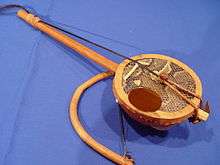Goje
| Classification |
|---|
The goje (the Hausa name for the instrument) is one of the many names for a variety of one or two-stringed fiddles from West Africa, almost exclusively played by ethnic groups inhabiting the Sahel and Sudan sparsely vegetated grassland belts leading to the Sahara. Snakeskin or lizard skin covers a gourd bowl, and a horsehair string is suspended on bridge. The goje is played with a bowstring.
The goje is commonly used to accompany song, and is usually played as a solo instrument, although it also features prominent in ensembles with other West African string, wind or percussion instruments, including the Shekere or Ney.
The various names by which the goje is known by include goge (Hausa, Zarma), gonjey (Dagomba, Gurunsi), gonje, (Mamprusi, Dagomba), njarka (Songhay), n'ko (Bambara, Mandinka and other Mande languages), riti (Fula, Serer), and nyanyeru or nyanyero.

See also
References
- Liner notes by Steve Jay in "Ghana: Ancient Ceremonies: Dance Music & Songs," Nonesuch Explorer Series, 1979, re-released, 2002. catalog number or ASIN: B00006C75Y
External links
- "Goge" at ASZA.com
- Nyanyeru at Musical Instrument Museum